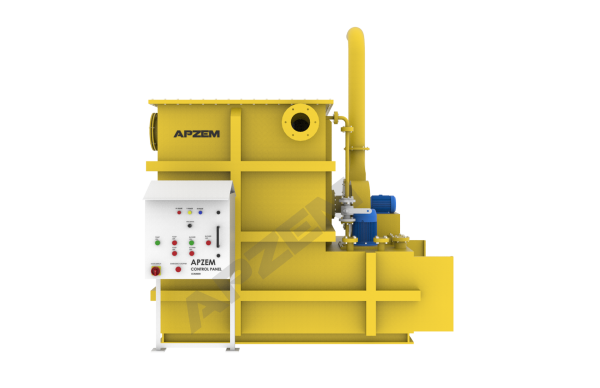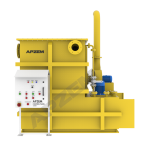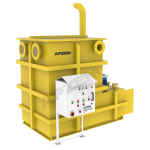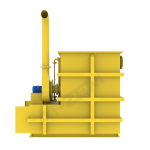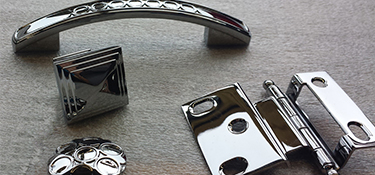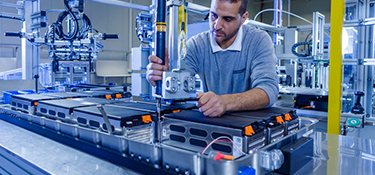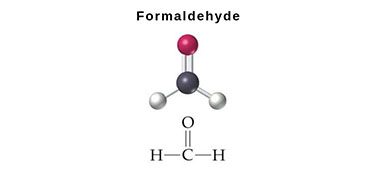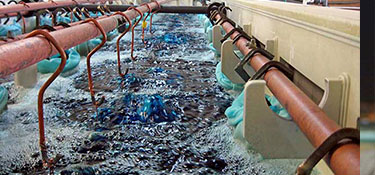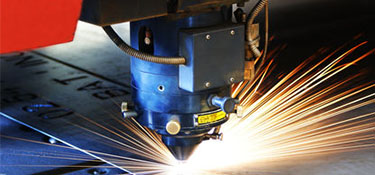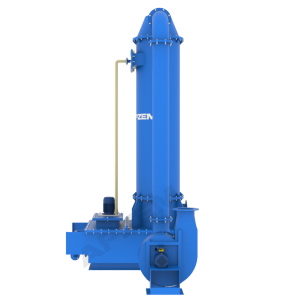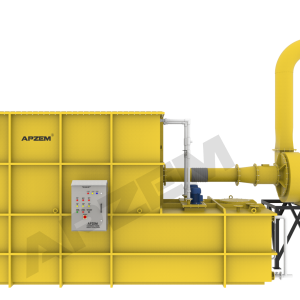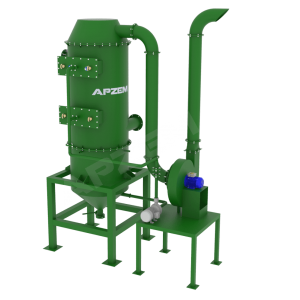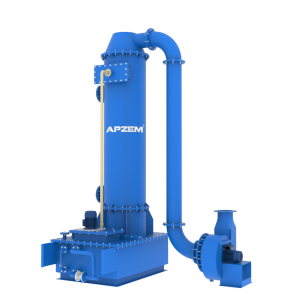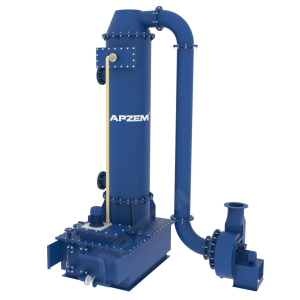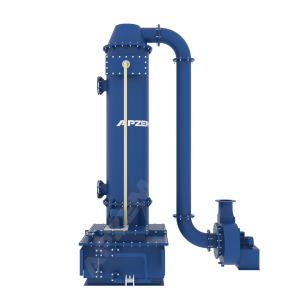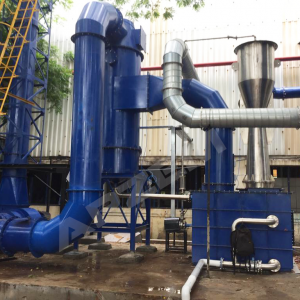Product Details
EMERGENCY SCRUBBER (250 CFM-For cylinder of 32 kg)
Apzem developed an Emergency Scrubber to protect from accidental leakage of poisonous gases such as Chlorine, Hydrogen Sulfide, Sulphur dioxide and Hydrogen Fluoride.
Product CatalogueDescription
EMERGENCY SCRUBBER (250 CFM-For cylinder of 32 kg)
Emergency Chlorine Scrubber
- Apzem developed an Emergency Scrubber to protect from accidental leakage of poisonous gases such as Chlorine, Hydrogen Sulfide, Sulphur dioxide and Hydrogen Fluoride.
- Chlorine: It is a toxic gas, attack the respiratory system, skin and eyes. It can accumulate low-lying areas and poorly ventilated areas because its density is higher than air. Chlorine will kill anything if it is exposed to atmosphere with high concentrations. It is very hazardous to the environment due to the toxic and corrosive properties of chlorine.
Exposure Limits for Chlorine
- Permissible Exposure Limit (PEL) : 1 ppm (3 mg/m3) (OSHA)
- Recommended Exposure Limit (REL) : 0.5 ppm (1.5 mg/m3) as Time Weighted Average up to 10 hours (NIOSH)
- Short-term exposure limit (STEL) : 1 ppm (3 mg/m3)
- Immediate dangerous to Life and Health (IDLH) : 10 ppm (NIOSH)
- The Emergency Chlorine scrubber is designed by following World Chlorine Council.
Chlorine cylinder
Typical chlorine cylinders are made of up of carbon steel, mostly 150 lb and 100 lb dominate in the market. Cylinders has a fusible plug which is located at cylinder valve. The fusible plug is designed to melt at 70 degree Celcius and release pressure in safely.
Scrubber design
The scrubber, absorption unit in which the chlorine is neutralized using caustic scrubbing liquid. The absorption unit is designed based on risk evaluation study to prevent release of chlorine directly to the atmosphere considering all possibility of situations.
The basic scenario considered are:
- Instantaneous high flow rate in worst condition
- Gas stream composition
- Maximum Chlorine absorption in Scrubber
The chlorine concentration at the point of leakage is should be monitored continuously and ensure the concentration is less than 3 mg/m3.
Worst case condition
The gas leak from the 150 lb (68 Kg) cylinder is 9 Kg /min. Hence it is required to design with suction of 250 CFM.
Neutralization of Chlorine
Chlorine is neutralized by caustic solution and gives by product of Sodium hypochlorite and Sodium Chloride.
Cl2 + 2 NaOH ⇒NaOCl + NaCl + H2O
Major Components in the Scrubber
1) Instrumentation with hood and ducting
2) Exhaust Blower
3) Scrubber with packed bed
4) Vents to Atmosphere
- The emergency scrubber consist of three stage chemical absorption section: 1 spray section and 2 packed bed column sections. The inlet gas enters horizontally in spray section where the caustic liquid is sprayed with high pressure at cross current direction, there by the scrubbing action takes place. After passing through the spray section, the gas enters into the packing section, where packing material is filled to increase the efficiency of scrubbing.
- The entire chlorine gas is neutralized before releasing into the atmosphere. A mist eliminator is placed tom remove any moisture or residual liquid droplets in the gas stream.
- The overall scrubbing efficiency is 99.999 % because it neutralizes the large amount of chlorine and releases only traces of chlorine gas at outlet. The entire system is fully automated. When it detects the chlorine gas from the leakage area, the sensor will detect the gas and send signal to star up scrubber system to capture and neutralize the chlorine.
HOW SYSTEM WORKS
- One common duct will run along the length of the of the Chlorine storage area, along the length of the Chlorine tank filling lines and loading area. Tonners (For example, 4 tonners) containing chlorine will be connected online with chlorine sensor. All the tonners will be provided with an online Chlorine gas monitoring system with hood covering tonner, nozzle and connection Manifolds. The hood part has both top Portion and other is bottom portion. Of which the bottom portion is fixed and the top portion is made removable. Whenever the Chlorine tanks are to be connected/removed from the online manifold, the top hood portion should be removed and the connections are made then the hood is placed in position. When the hood is in closed condition, it nearly forms a closed atmosphere preventing the Chlorine from escaping out of the hoods with minimal leakages.
- All the hoods are connected to the main ducting line. The electrically actuated damper will be controlled by PLC based micro controller system. All the Branch ducting from the loading tanks and online Chlorine tanks will be connected to a main header line and connected to the Scrubber.
- When the chlorine gets leaked in a particular tank it will be detected by the Chlorine gas monitors and the corresponding main line damper gets automatically opened and the scrubber & blower arrangement will be switched on automatically. Thus creating a negative pressure in the particular line, this causes the Chlorine gas to be removed from the tank drawing area without any human intervention. As an emergency option electrically actuated damper will be provided with individual emergency damper opening controller nearby to operate the damper even in case of faulty operation of Chlorine sensors. Normally all the dampers will be in Normally Open condition. Wet scrubber will treat the Chlorine gas by caustic soda solution and throw the cleaned air into the atmosphere via blower and chimney of height 6.5 m from the ground level.
- The Emergency scrubber is tested independently in field with a one full ton of chlorine gas release. While testing, the accident was simulated with chlorine gas release of 45 kg/min. When it releases, the chlorine concentration was 500000 ppm and could be reduced less than 5 ppm.
Features of Emergency Chlorine Scrubber
- Material is constructed with FRP for corrosion resistance and strength
- Tank is designed to contain scrubbing liquid to treat to full amount (68 Kg) of chlorine tonner
- Fully automated system and also can be operated manually
- Online chlorine gas monitoring
- Standby Exhaust Blower
- Standby pump
- Proven in working at situation of catastrophic gas cylinder from chlorine cylinder and achieves vapour removal efficiency of 99.999%
- Minimum maintenance
- Guaranteed Performance
Applications Emergency Chlorine Scrubber
- Organic and Inorganic Chemical manufacturing Industries
- Pharmaceutical Industries
- Textile Industries
- Wastewater treatment plants
DESIGN BASIS
- AS PER ACGIH STANDARDS
- Emergency scrubber is designed to suit the release of H2S
- Total CFM = 250 CFM
DIMENSION: 2450 mm (L) X 1400 (W) X 2000 (H) mm
TYPE: WET TYPE PACKED BED
ACCESSORIES
- PACKING REMOVAL AND FILL-UP ACCESS.
- CLEANOUT PORTS.
- PACKING SUPPORT GRID
SAFETY ACCESSORIES
- DRAIN VALVE WITH BALL VALVE
- WATER INLET VALVE
- OVERFLOW PROVISION
- WATER LEVEL INDICATOR
- INSPECTION GLASS PORT FOR PACKING AREA
Blower
- 250 CFM
- PP+FRPVE Blower
- 1 HP Three Phase Power supply With VFD drive
- Make: Siemens/ABB/BBL.
https://www.apzem.in/index.php/product-category/scrubber/emergency-scrubber/

